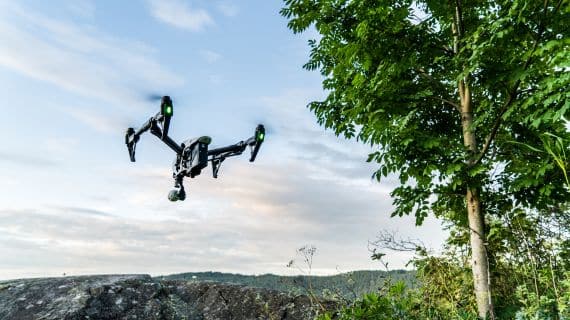Drones For Wildlife Photography – Drone news and reviews


The fascinating and challenging field of wildlife photography has been revolutionized by drone technology, providing new opportunities to capture stunning images of the natural world. However, the use of drones for wildlife photography also presents unique challenges and ethical considerations. In this blog post, we will explore how to choose a suitable drone for wildlife photography, the importance of ethical practices, best practices to minimize the impact of drone usage on animals and their habitats, drone accessories, photography techniques, and building a portfolio.
Choosing the Right Drone for Wildlife Photography
When selecting the ideal drone for wildlife photography, it’s important to consider camera quality, flight performance, noise reduction features, and automated flight modes. Here, we discuss four popular drone models, each with unique strengths and capabilities suited for capturing stunning images and videos of wildlife.
DJI Mavic 3
The DJI Mavic 3 is a highly versatile drone with a compact design andpowerful features. It boasts a dual camera system; the primary camera has a 20-megapixel Hasselblad sensor that captures stunning images and 5.1K video resolution, making it perfect for wildlife photography. The secondary camera has a telephoto lens with a 28x hybrid zoom capability, allowing users to get amazing shots of their subjects without disturbing them. With a remarkable flight time of up to 46 minutes, the Mavic 3 also features omnidirectional obstacle avoidance, ensuring safe and reliable flights in challenging environments. The drone offers several intelligent flight modes to help users easily capture dynamic shots.
DJI Air 2S
The DJI Air 2S is another popular choice for wildlife photographers, thanks to its compact design, powerful camera, and impressive flight capabilities. The drone features a 1-inch CMOS sensor, capturing 20-megapixel photos and 5.4K video resolution. Its 4x lossless zoom helps photographers get close to their subjects without causing a disturbance. With a flight time of up to 31 minutes and advanced obstacle avoidance technology, the Air 2S ensures safe flights and smooth footage. It also includes various intelligent flight modes, such as ActiveTrack and Point of Interest, to assist users in capturing compelling wildlife shots.
Autel Evo 2
The Autel Evo 2 stands out with its impressive camera options and robust flight performance. The drone has a large 20MP 1-inch image sensor, offering unparalleled image quality for wildlife photography. It has 16x zoom (3x lossless) and enables close-ups of animals without losing quality. The Evo 2 boasts a flight time of up to 40 minutes and features omnidirectional obstacle avoidance for safe navigation in complex environments. It also includes multiple intelligent flight modes, such as Dynamic Track and Tripod Track, to help users create stunning wildlife compositions.
DJI Mavic 2 Zoom
The DJI Mavic 2 Zoom is a popular drone for wildlife photography, primarily due to its unique zoom capabilities. The drone features a 12-megapixel sensor with 2x optical zoom (24-48mm) and 4x lossless zoom, allowing photographers to capture close-up shots of animals without getting too close. It records 4K video resolution and has a flight time of up to 31 minutes. The Mavic 2 Zoom also includes omnidirectional obstacle avoidance, ensuring safe flights in challenging conditions. It offers a range of intelligent flight modes, such as Hyperlapse and Dolly Zoom, which enable users to create creative and engaging wildlife imagery.
Drone Accessories for Wildlife Photography
Investing in essential accessories can significantly improve your wildlife drone photography experience. Some key accessories to consider include:
- Polarizing and ND filters for better image quality, extra batteries for extended flight time- Portable chargers for on-the-go power
- Protective cases for safe transport
- - Top-down or bird’s-eye view shots: One of the most striking perspectives that drones offer is the bird’s-eye view, which allows you to capture wildlife and their habitats from directly above. This top-down approach can reveal intricate patterns, textures, and relationships within the landscape that are not visible from ground level. When photographing animals from above, be cautious not to disturb them and maintain a safe distance to minimize any potential stress.
- Panoramic photography for wide-angle landscapes: Drones enable you to capture stunning panoramic images that showcase the vastness and beauty of the natural world. By taking a series of overlapping photos and stitching them together in post-processing, you can create breathtaking wide-angle shots that encompass entire landscapes and habitats. This technique can be particularly effective for showcasing the scale of an animal’s environment and emphasizing the relationship between the subject and its surroundings.
- Creating motion blur or long exposure shots: By slowing down your drone’s shutter speed, you can create motion blur or long exposure effects that convey a sense of movement and dynamism in your wildlife photos. This technique is particularly effective when photographing animals in motion, such as birds in flight or a herd of animals on the move. When using slower shutter speeds, it’s essential to maintain a steady drone position and use a gimbal to stabilize your camera, ensuring sharp and well-composed images.
- Using waypoints for pre-planned flight paths: Some drone models offer waypoint functionality, allowing you to plan and execute complex flight paths with precision. By setting up a series of waypoints and configuring your drone to follow the pre-planned route, you can focus on framing and capturing the perfect shot without worrying about navigating the drone manually. This technique can be particularly useful when tracking the movement of animals over time or capturing a specific sequence of events in their natural habitat. Always ensure that your pre-planned flight path does not disturb or pose a threat to the wildlife you’re photographing.
- - Prioritize animal welfare: The well-being of the animals should always come first. Avoid any actions that may cause stress, disturbance, or harm to the wildlife or their habitats. Be aware of the animal’s behaviour, and if you notice any signs of distress or anxiety, retreat to a safe distance or cease your photography efforts.
- Respect boundaries and local regulations: Adhere to local laws, guidelines, and posted signs when photographing wildlife, especially in protected areas or national parks. These rules are in place to protect the animals and their environment. Do not trespass or enter restricted areas in pursuit of the perfect shot.
- Keep a safe distance: Maintain an appropriate distance from the animals to minimize disturbance and reduce the risk of causing stress. Use zoom lenses or drone cameras with powerful zoom capabilities to capture close-up shots without getting too close. Be especially cautious around nesting sites, breeding grounds, and young animals.
- Please do not feed or bait wildlife: Providing food or bait to attract animals can disrupt their natural behaviour, alter their feeding habits, and even harm them. Photographing animals behaving naturally and not interfering with their normal routines is essential.
- Educate yourself about the species: Research and understand the behaviour, habitat, and needs of the species you are photographing. This knowledge will enable you to anticipate their actions, recognize signs of stress, and minimize your impact on their lives.
- Practice patience: Wildlife photography often requires patience and perseverance. Avoid the temptation to force an interaction or manipulate an animal’s behaviour for the sake of a photograph. Allow events to unfold naturally and respect the animals’ space and needs.
By adhering to these ethical considerations, wildlife photographers can contribute to the responsible and sustainable practice of capturing the beauty and wonder of the natural world while prioritizing the well-being of the animals and their habitats.
How Do Drones Affect Wildlife?
As detailed by the popular photography website fstoppers.com, drone-animal interactions can cause harm to wildlife, and photographers have an ethical obligation to minimise the impact of their actions. Two incidents are highlighted in the article, one in India and Michigan.
Both incidents involved the interaction between an eagle and a drone; while the one in Michigan seemingly had no adverse effect on the eagle, the Indian episode may have caused the eagle some injury. Having said that, in both situations, the operators were not using their drones for wildlife photography, and the drone pilot in India did not realise there were eagles in the area, so there is no blame on them.
However, both these incidents have emphasised the need for caution when using drones around animals. Both incidents would have been avoidable if recommended best practices had been followed.
Some studies have shown that drones have a negative effect on animals, leading to increased heart rates, anxious behaviour, and potential changes to reproductive processes. To minimise the impact of drones on animals, photographers should use small and low-noise drones, keep flights as short as possible, fly at the highest altitude possible, and monitor animal behaviour, among other recommendations. Flying drones around animals should only be done by experienced pilots who understand the animals and their potential responses to the stress of a drone.
Final Thoughts
Drones have undoubtedly revolutionised photography, offering new perspectives and opportunities to capture the beauty of the natural world. However, it is crucial for photographers to approach wildlife photography with caution and respect for the animals and their habitats. By choosing the right equipment, adhering to ethical guidelines, mastering different techniques, and following best practices, photographers can contribute to the responsible use of drone technology in wildlife photography and help ensure a sustainable future for this exciting and rapidly evolving field.
https://skydanceimaging.com/drones-for-wildlife-photography-drone-news-and-reviews/

Comments
Post a Comment